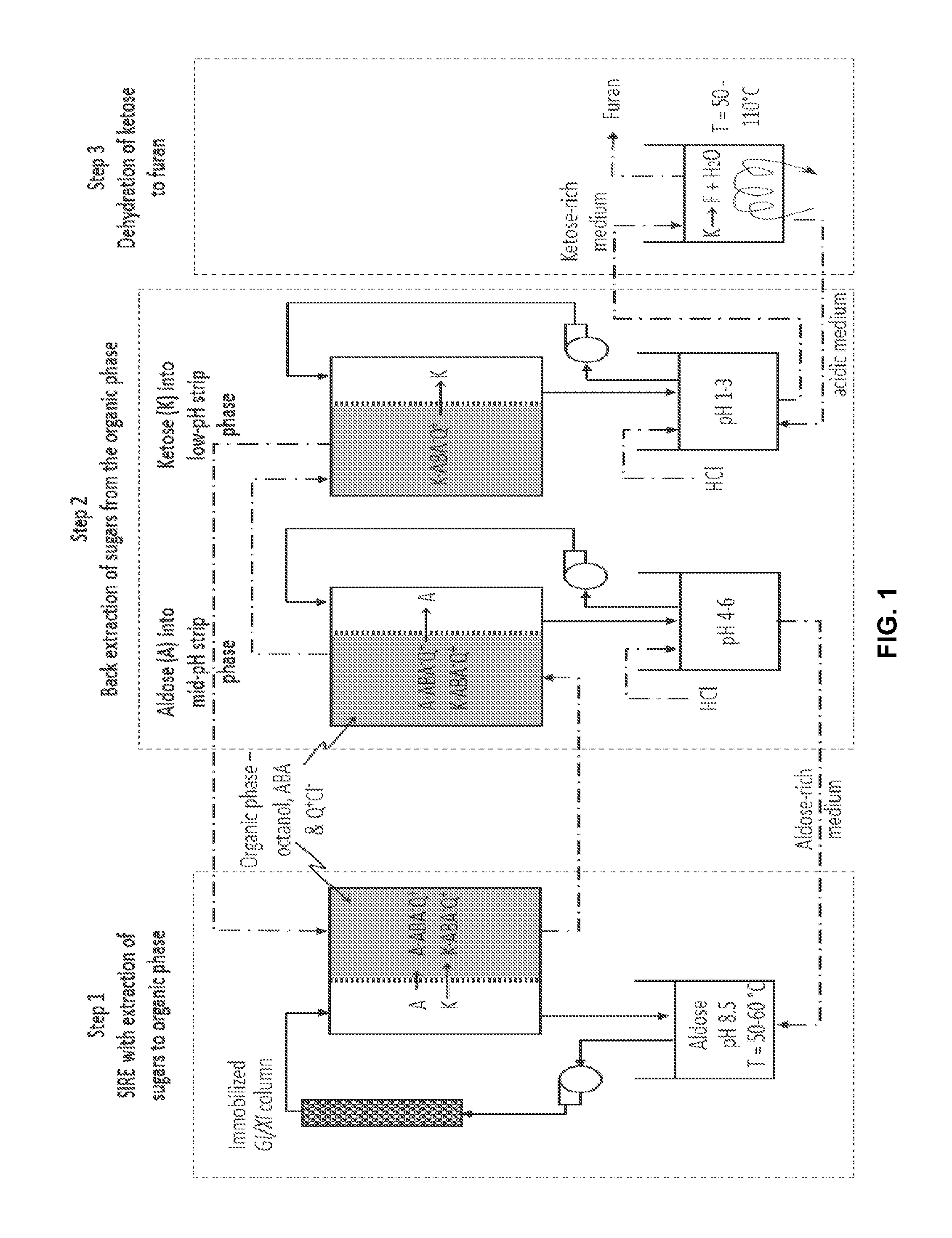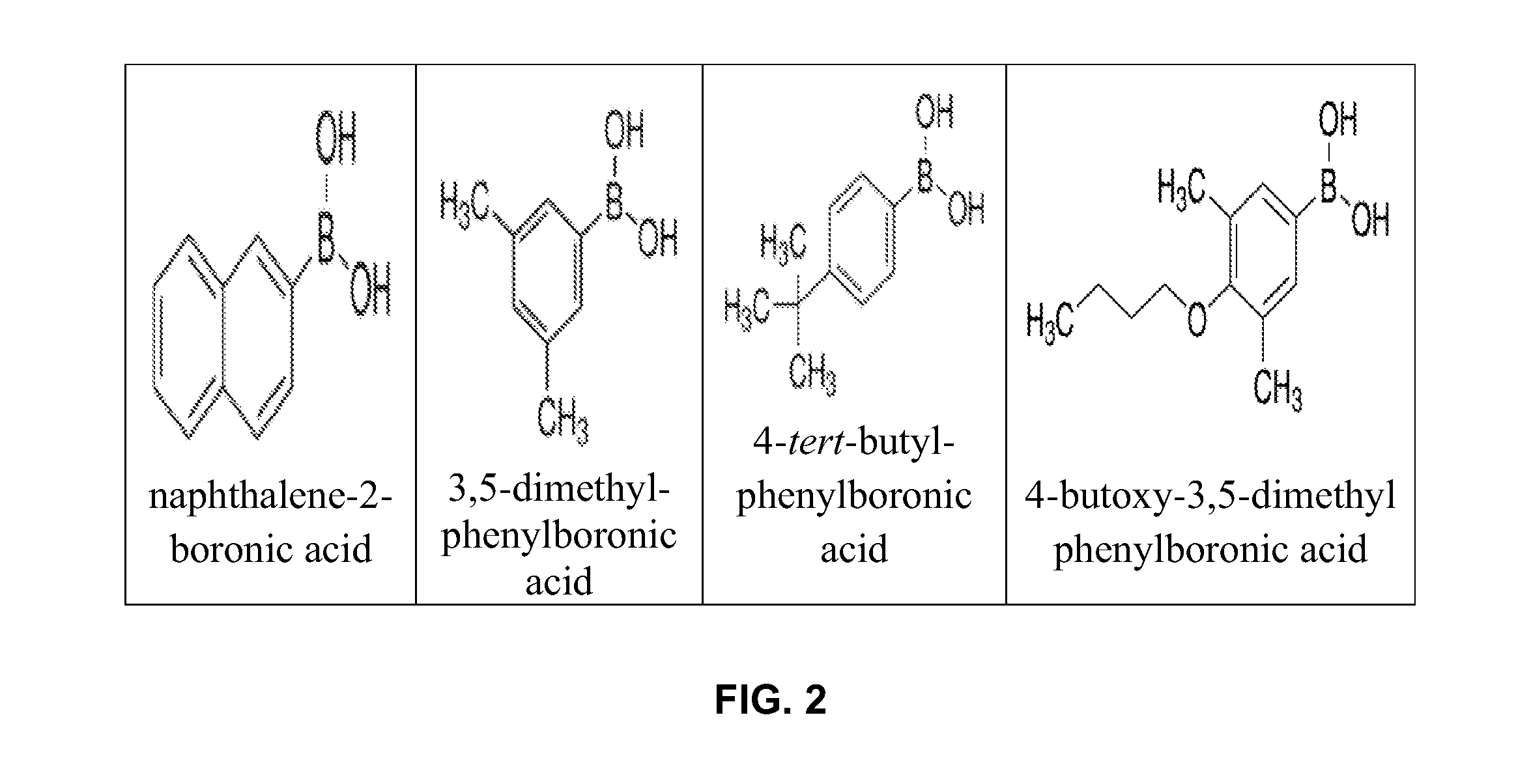Methods for High Yield Production of Furans from Biomass Sugars at Mild Operating Conditions
a biomass sugar and high-yield technology, applied in the field of high-yield production of furans from biomass sugars at mild operating conditions, can solve the problems of significant sugar loss, high reaction temperature and pressure, and several limitations of the method of producing furans from the c5 and c6 sugars of lignocellulosic biomass, and achieve the effect of increasing the conversion of aldose to keton
- Summary
- Abstract
- Description
- Claims
- Application Information
AI Technical Summary
Benefits of technology
Problems solved by technology
Method used
Image
Examples
example 1
Evaluation of Several ABAs and Organic Solvents for Establishing a Viable Reactive Extraction Phase for Implementation of SIRE
[0070]Several ABAs were evaluated for their characteristics with SIRE-BE and production of an extracted ketose solution suitable for dehydration to furan. Several suitable liquid-phase ABAs tested are shown in FIG. 2. These ABAs are all lipophilic and can be confined to the organic phase with the assistance of an ion pairing quaternary amine salt such as Aliquat® 336. To assess the suitability of these ABAs for use in SIRE, the first criterion assessed was the ability to preferentially bind ketose sugar over aldose sugar at a pH compatible with the sugar isomerization by the enzyme XI. As such, these complexing agents were evaluated for their ability to extract individual sugars from the aqueous to the organic phase over a range of pH values. Individual experiments conducted showed higher ketose extraction than aldose extraction; the ratios of these sugar ext...
example 2
Optimum Sugar-to-ABA Ratio to Maximize Ketose Yield (PBA, N2B, FIGS. 5, 6A-6B)
[0072]3-amino phenyl boronic acid (3aPBA) was immobilized by covalently binding the amino group to an oxirane-functionalized solid support material to achieve solid-phase sugar complexing medium. A xylose sugar solution buffered to pH 8.5 was recirculated through two packed beds, one containing immobilized XI particles and one containing immobilized PBA particles, connected in series. Xylulose formed via XI-catalyzed isomerization binds preferentially to the immobilized PBA, thus driving the xylose to xylulose isomerization forward in the aqueous medium. Following SIRE, the xylulose bound to the immobilized PBA column was back-extracted by flushing the column with low pH medium. Through implementation of SIRE with various xylose-to-PBA ratios, an optimum ratio for xylulose production was established, as shown in FIG. 5.
[0073]To test the capacity for separation of aldose from ketose isomers, liquid-liquid S...
example 3
Evaluation of IL Compatibility with the Extraction Phase (Miscibility) and Efficiency Of Fructose Extraction
[0074]In the prior examples, an HCl-acidified aqueous phase was used for the BE and dehydration medium. Since ionic liquids show considerable flexibility for green chemistry at low temperatures, several ILs were evaluated for their suitability as media to facilitate back-extraction and fructose dehydration. For these experiments, all sugars, solvents for SIRE and for in situ dehydration of fructose, furans, ABAs, Aliquat® 336, and ionic liquids were purchased from Sigma Aldrich Co (St. Louis, Mo., USA). HCl and the solid acid catalysts Wet Amberlyst 15 (Acros Organic Co.) and Amberlyst 70 (Dow Chemical Co.) were evaluated for their ability to improve the fructose extraction and to catalyze the dehydration. All other chemicals and solvents were purchased from Thermo Fisher Scientific Inc. (Pittsburgh, Pa., USA).
[0075]The first stage of the IL screening as a back-extraction and ...
PUM
| Property | Measurement | Unit |
|---|---|---|
| temperature | aaaaa | aaaaa |
| temperature | aaaaa | aaaaa |
| temperature | aaaaa | aaaaa |
Abstract
Description
Claims
Application Information
 Login to View More
Login to View More - R&D
- Intellectual Property
- Life Sciences
- Materials
- Tech Scout
- Unparalleled Data Quality
- Higher Quality Content
- 60% Fewer Hallucinations
Browse by: Latest US Patents, China's latest patents, Technical Efficacy Thesaurus, Application Domain, Technology Topic, Popular Technical Reports.
© 2025 PatSnap. All rights reserved.Legal|Privacy policy|Modern Slavery Act Transparency Statement|Sitemap|About US| Contact US: help@patsnap.com



